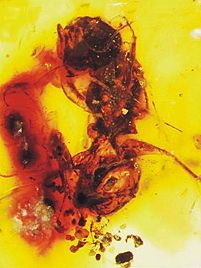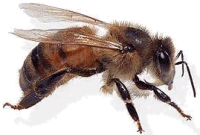WHERE HONEY BEES CAME FROM

The first bees appear about 100 million years ago and are preserved in amber from the Cretaceous Period. At about 30 million years ago they appear to have developed social behaviour and structurally are virtually identical to the bees we have today.
Solitary bee species such as the bumblebee die out every year leaving only a few young queens to survive the Winter and start a new colony in Spring. Out of the four types of honey bee this site is concerned only with the western honeybee, Apis mellifera.
Apis mellifera probably originated in Tropical Africa and spread from South Africa to Northern Europe and West into India and China. They were taken to the Americas with the first colonists and are now distributed world-wide.
Honey bees live in communities all year round, having a Summer population of 50-60,000 and a Winter population of about 10,000. They are divided into three types: Queen, Drone, and Worker.
The Apis mellifera found in Europe has developed certain characteristics according to its geographical location so a number of different varieties have evolved.
The Italian honeybee is pale in colour and is good-tempered, resistant to disease and reluctant to swarm. Its main disadvantage is that it rears an excessive amount of brood and therefore uses up its stores very quickly.
The Carniolan honeybee is native to Austria and is easily identified by broad white bands on its abdomen. This bee is very good-tempered but is prone to swarming.
The Caucasian honeybee is greyish in colour with pale bands on its abdomen. It is a very gentle bee but tends to use excessive amounts of propolis which makes the hives very difficult to manipulate.
The French honeybee is dark in colour. It is a very hard-working and productive bee but it is very aggressive and can be difficult to manage.
The Dutch honeybee is dark brown in colour and was brought to Britain after 1920 to replace stocks of native bees lost during an epidemic of acarine disease. This bee is very productive but has a tendency to swarm.
Some beekeepers are attempting to develop strains of honeybees with all the desirable characteristics of the existing types of bee. The ideal honeybee is docile, resistant to disease and reluctant to swarm. It uses its food stores economically and produces good crops of honey.
